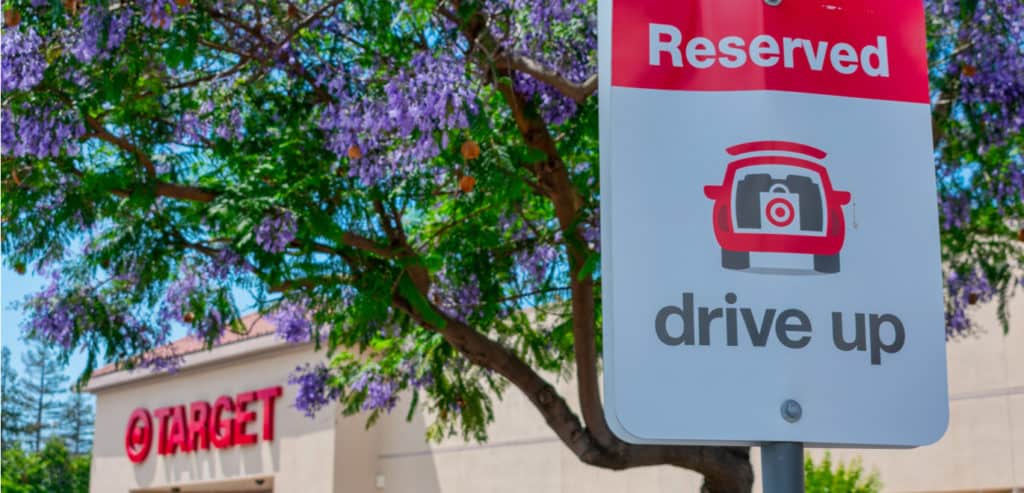Target Corp. reported a 34% increase in ecommerce sales year over year for its second fiscal quarter ending Aug. 3, but it didn’t disclose exact figures.
Same-day fulfillment, including in-store pickup, curbside pickup and orders delivered by Shipt, is the fastest-growing part of the digital channel and accounted for a third of ecommerce revenue and three quarters of ecommerce growth. Nearly 1.5 percentage points of the retailer’s 3.6% total revenue growth came from ecommerce growth. Shipt is a same-day delivery service acquired by Target in 2017.
Altogether, revenue from orders fulfilled on the day they were placed has doubled in the last year. These same-day orders also are the retailer’s most profitable digital offering, according to chief operating officer John Mulligan speaking to investors on a call transcribed by Seeking Alpha. Target grew income 16.9% overall for the quarter to $1.324 billion from $1.133 billion a year ago.
Improved profitability comes thanks to improved store fulfillment efficiency, Mulligan said, not higher-margin sales. Both ship-from-store and pickup-from-store order picking efficiency have improved 30% since the start of 2018, and a majority of digital orders are fulfilled from stores, he said.
Tactics that led to that increase in efficiency include picking orders in larger batches, making it clearer which exact items need to be picked and optimizing picking paths so that employees don’t have to go from the back of the store to the retail floor repeatedly, Mulligan said.
“As we shift our fulfillment from upstream distribution centers to our stores, we see our cost go down by upwards of 40%,” said CEO Brian Cornell. “When it moves to one of our same-day options, pick up in-store, drive-up or Shipt, we see a 90% reduction in that cost.”
These efficiency increases also improved customer satisfaction, he said. For example, the average wait for a drive-up order is two minutes once the driver pulls into the parking lot, which is Mulligan said is better than the industry standard. In addition, Target altered its return process, and now grants refunds as soon as return packages are scanned into a shipping carrier’s system, which cuts days off refund wait times, Mulligan said. This also has improved customer satisfaction, he said.
Target will continue to use its stores as fulfillment hubs, and Mulligan said the retailer’s existing store footprint won’t hold back its vision for the supply chain. If the retailer doubled ecommerce sales, and stores fulfilled all of the growth, Mulligan said productivity per square foot would have to rise just $20. The top stores improved productivity per square foot by $430 last year, so a $20 improvement is achievable across the chain.
Space also is a concern, but Mulligan said the current backroom capacity can handle the next decade of growth, assuming Target maintains the same processes and technology. Even then, it would only get constrained for a two-week period during the holidays. Target also is in the midst of overhauling more than 300 stores and will continue to tune processes and technology for ecommerce orders, Mulligan said.
Target’s Deal Days, which competed with Amazon Prime Day, had “outstanding” results, according to Cornell, without revealing specific data. He also noted that the sales days allowed Target to test its operations ahead of the holiday sales season and that those tests proved the company was ready for the holiday season.
Target is No. 16 in the Internet Retailer 2019 Top 1000.
In other earnings news:
- Furniture manufacturer La-Z-Boy Inc. (No. 522) reported that online-only furniture brand Joybird brought in $17.2 million in sales for its second fiscal quarter ended July 27. La-Z-Boy acquired Joybird a year ago, and it has since generated $76 million in sales for the retailer, said CEO Kurt Darrow in a call with investors transcribed by Seeking Alpha. That’s up 38.2% from the previous 12 months when Joybird generated $55 million in sales. However, the brand is still not profitable as supply chain integrations between the brands lag expectations. Darrow said it should be profitable by the end of the year as production at the company’s Tennessee plant ramps up.
- Victoria’s Secret owner L Brands Inc. (No. 39) reported a 10.5% increase in direct sales for its second fiscal quarter ending Aug. 4 to $551.5 million from $499.3 million during the same period last year. The retailer updated the platform that runs its Victoria’s Secret site, setting it up to be able to provide customers the option to buy online and pick up in stores. The updated in-house platform allows more precise inventory tracking and integrates with an RFID system to show in-store inventory.
